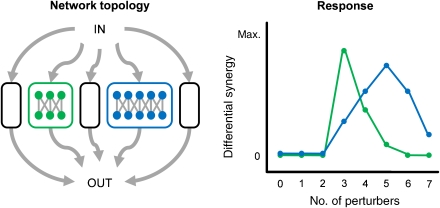Figure 3.
Expected differential synergy in modular systems. Biological networks are organized into modules, some with differing levels of functional redundancy (Hartwell et al, 1999; Gavin et al, 2002; Ideker and Lauffenburger, 2003). Experiments that focus on different modules, based on which perturbing agents and end points are chosen, should yield differential synergy peaks at combination orders that reflect the complexity of the sampled modules. In this example with multiple essential modules, probe sets targeting nodes in the green module will have COFs at three agents, whereas those targeting the blue module will peak at five perturbers. In this way, systematically testing increasing combination orders for a variety of probe end point sets can yield information on many aspects of the total system's complexity and robustness.

